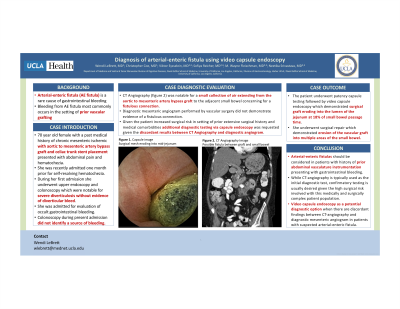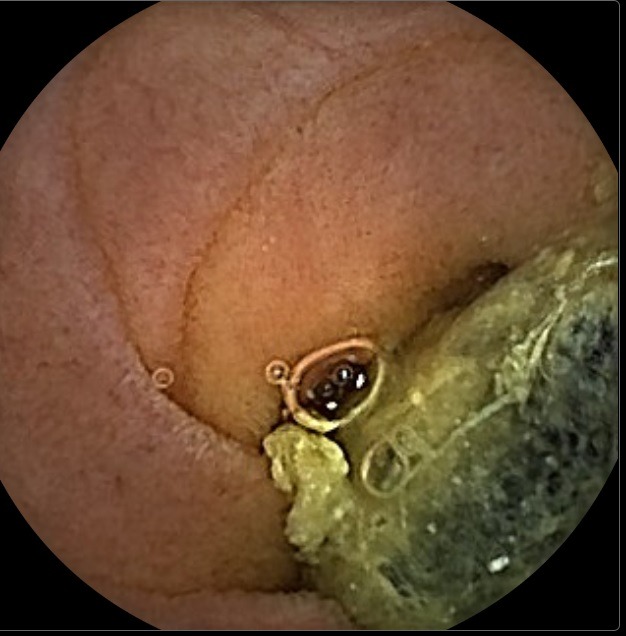Monday Poster Session
Category: GI Bleeding
P2052 - Diagnosis of Arterial-enteric Fistula Using Video Capsule Endoscopy
Monday, October 23, 2023
10:30 AM - 4:15 PM PT
Location: Exhibit Hall

Has Audio
- WL
Wendi LeBrett, MD
UCLA David Geffen School of Medicine
Los Angeles, California
Presenting Author(s)
Wendi LeBrett, MD1, Christopher Coe, MD1, Viktor Eysselein, MD2, Sofiya Reicher, MD2, Michael Wayne Fleischman, MD2, Neetika Srivastava, MD2
1UCLA David Geffen School of Medicine, Los Angeles, CA; 2Harbor-UCLA Medical Center, Torrance, CA
Introduction: Arterial-enteric fistula is a rare cause of gastrointestinal bleeding and most commonly occurs in the setting of prior vascular grafting. Here we discuss a case of recurrent occult gastrointestinal bleeding where arterial-enteric fistula was diagnosed using video capsule endoscopy.
Case Description/Methods: A 70 year old female with past medical history of chronic mesenteric ischemic with aortic to mesenteric artery bypass graft and celiac trunk stent placement presented with abdominal pain and hematochezia. She was recently admitted one month prior for self-resolving hematochezia. During her first admission she underwent upper endoscopy and colonoscopy which were notable for severe diverticulosis without evidence of diverticular bleed. She underwent a subsequent colonoscopy during her second admission which did not identify a source of bleeding. CT Angiography was notable for a small collection of air extending from the aortic to mesenteric artery bypass graft to the adjacent small bowel concerning for a fistulous connection. Diagnostic mesenteric angiogram performed by vascular surgery did not demonstrate evidence of a fistulous connection. Given the patient’s prior extensive surgical history and medical comorbidities she was deemed to be high surgical risk and additional diagnostic testing was requested given the discordant results between CT Angiography and diagnostic angiogram. The patient underwent patency capsule testing followed by video capsule endoscopy which demonstrated surgical graft eroding into the lumen of the jejunum at 18% of small bowel passage time. She underwent surgical repair which confirmed the diagnosis of arterial-enteric fistula with erosion of the vascular graft into multiple areas of the small bowel.
Discussion: Arterial-enteric fistula should be considered in patients with history of prior abdominal vasculature instrumentation presenting with gastrointestinal bleeding. While CT angiography is typically used as the initial diagnostic test, confirmatory testing is usually desired given the high surgical risk involved with this medically and surgically complex patient population. Our case illustrates video capsule endoscopy as a potential diagnostic option when there are discordant findings between CT angiography and diagnostic mesenteric angiogram in patients with suspected arterial-enteric fistula.

Disclosures:
Wendi LeBrett, MD1, Christopher Coe, MD1, Viktor Eysselein, MD2, Sofiya Reicher, MD2, Michael Wayne Fleischman, MD2, Neetika Srivastava, MD2. P2052 - Diagnosis of Arterial-enteric Fistula Using Video Capsule Endoscopy, ACG 2023 Annual Scientific Meeting Abstracts. Vancouver, BC, Canada: American College of Gastroenterology.
1UCLA David Geffen School of Medicine, Los Angeles, CA; 2Harbor-UCLA Medical Center, Torrance, CA
Introduction: Arterial-enteric fistula is a rare cause of gastrointestinal bleeding and most commonly occurs in the setting of prior vascular grafting. Here we discuss a case of recurrent occult gastrointestinal bleeding where arterial-enteric fistula was diagnosed using video capsule endoscopy.
Case Description/Methods: A 70 year old female with past medical history of chronic mesenteric ischemic with aortic to mesenteric artery bypass graft and celiac trunk stent placement presented with abdominal pain and hematochezia. She was recently admitted one month prior for self-resolving hematochezia. During her first admission she underwent upper endoscopy and colonoscopy which were notable for severe diverticulosis without evidence of diverticular bleed. She underwent a subsequent colonoscopy during her second admission which did not identify a source of bleeding. CT Angiography was notable for a small collection of air extending from the aortic to mesenteric artery bypass graft to the adjacent small bowel concerning for a fistulous connection. Diagnostic mesenteric angiogram performed by vascular surgery did not demonstrate evidence of a fistulous connection. Given the patient’s prior extensive surgical history and medical comorbidities she was deemed to be high surgical risk and additional diagnostic testing was requested given the discordant results between CT Angiography and diagnostic angiogram. The patient underwent patency capsule testing followed by video capsule endoscopy which demonstrated surgical graft eroding into the lumen of the jejunum at 18% of small bowel passage time. She underwent surgical repair which confirmed the diagnosis of arterial-enteric fistula with erosion of the vascular graft into multiple areas of the small bowel.
Discussion: Arterial-enteric fistula should be considered in patients with history of prior abdominal vasculature instrumentation presenting with gastrointestinal bleeding. While CT angiography is typically used as the initial diagnostic test, confirmatory testing is usually desired given the high surgical risk involved with this medically and surgically complex patient population. Our case illustrates video capsule endoscopy as a potential diagnostic option when there are discordant findings between CT angiography and diagnostic mesenteric angiogram in patients with suspected arterial-enteric fistula.

Figure: Capsule image showing vascular graft eroding into the small bowel lumen
Disclosures:
Wendi LeBrett: Trellus Health – Consultant.
Christopher Coe indicated no relevant financial relationships.
Viktor Eysselein indicated no relevant financial relationships.
Sofiya Reicher: Boston Scientific – Consultant.
Michael Wayne Fleischman indicated no relevant financial relationships.
Neetika Srivastava indicated no relevant financial relationships.
Wendi LeBrett, MD1, Christopher Coe, MD1, Viktor Eysselein, MD2, Sofiya Reicher, MD2, Michael Wayne Fleischman, MD2, Neetika Srivastava, MD2. P2052 - Diagnosis of Arterial-enteric Fistula Using Video Capsule Endoscopy, ACG 2023 Annual Scientific Meeting Abstracts. Vancouver, BC, Canada: American College of Gastroenterology.
